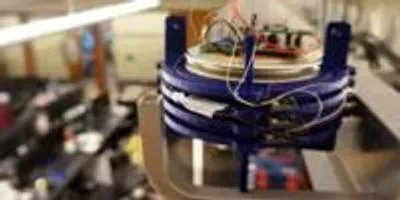 The device could be placed in hard-to-reach areas where temperatures fluctuate slightly.University of WashingtonThe clock, powered by changes in temperature and atmospheric pressure, was invented in the early 17th century by a Dutch builder. Three centuries later, Swiss engineer Jean Leon Reutter built on that idea and created the Atmos mechanical clock that can run for years without needing to be wound manually.
The device could be placed in hard-to-reach areas where temperatures fluctuate slightly.University of WashingtonThe clock, powered by changes in temperature and atmospheric pressure, was invented in the early 17th century by a Dutch builder. Three centuries later, Swiss engineer Jean Leon Reutter built on that idea and created the Atmos mechanical clock that can run for years without needing to be wound manually.
Now, University of Washington researchers have taken inspiration from the clock’s design and created a power harvester that uses natural fluctuations in temperature and pressure as its power source. The device harvests energy in any location where these temperature changes naturally occur, powering sensors that can check for water leaks or structural deficiencies in hard-to-reach places and alerting users by sending out a wireless signal.
“Pressure changes and temperature fluctuations happen around us all the time in the environment, which could provide another source of energy for certain applications,” said Shwetak Patel, a UW associate professor of computer science and engineering and of electrical engineering.
The UW team will present its research at the Association for Computing Machinery’s International Joint Conference on Pervasive and Ubiquitous Computing this month in Seattle.
The system works like this: A metal bellows about the size of a cantaloupe is filled with a temperature-sensitive gas. When the gas heats and cools in response to the outside air temperature, it expands and contracts, causing the bellows to do the same. Small, cantilever motion harvesters are placed on the bellows and convert this kinetic energy into electrical energy. This powers sensors that also are placed on the bellows, and data collected by the sensors is sent wirelessly to a receiver.
A number of battery-free technologies exist that are powered by solar and ambient radio frequency waves. The researchers say this technology would be useful in places where sun and radio waves can’t always penetrate, such as inside walls or bridges and below ground where there might be at least small temperature fluctuations.
For instance, the device could be placed in an attic or inside a wall, and sensors would be tuned to check for water leaks. Similarly, when used inside a bridge, the sensors could detect any cracks forming or structural deficiencies. In both cases, the sensors would send a signal to the nearby powered receiver.
 The power harvester could be placed outside and runs off of temperature changes in the natural world.University of WashingtonA temperature change of only 0.25 degrees Celsius creates enough energy to power the sensor node to read and send data wirelessly to a receiver 5 meters away. That means any slight shift in an office building’s air conditioning or the natural outside air temperature during the course of a day would be more than enough to activate the chemical in the bellows.
The power harvester could be placed outside and runs off of temperature changes in the natural world.University of WashingtonA temperature change of only 0.25 degrees Celsius creates enough energy to power the sensor node to read and send data wirelessly to a receiver 5 meters away. That means any slight shift in an office building’s air conditioning or the natural outside air temperature during the course of a day would be more than enough to activate the chemical in the bellows.
The UW’s technology uses temperature changes over time as its power source. Devices called thermoelectric generators also leverage varying temperatures for power, but these instruments require a temperature difference at an exact moment, such as in a place where one side is hot and the other is cool.
The researchers have filed patents for the technology and plan to make it smaller, about the size of a D battery. A future version would include four chemicals that activate in different temperature ranges so the same device could be used in various climates.
“I think our approach is unique,” said Chen Zhao, lead author and a UW doctoral student in electrical engineering. “We provide a simple design that includes some 3-D printed and off-the-shelf components. With our Web page and source code, others can download and build their own power harvesters.”
Other members of the research team are Joshua Smith, a UW associate professor of computer science and engineering and of electrical engineering; Sam Yisrael, an undergraduate student in electrical engineering; Sidhant Gupta, a former UW doctoral student; and Eric Larson, an assistant professor at Southern Methodist University and former UW doctoral student.
This research was funded by the Intel Science and Technology Center for Pervasive Computing at the UW and the Sloan Foundation.
The clock, powered by changes in temperature and atmospheric pressure, was invented in the early 17th century by a Dutch builder. Three centuries later, Swiss engineer Jean Leon Reutter built on that idea and created the Atmos mechanical clock that can run for years without needing to be wound manually.
Now, University of Washington researchers have taken inspiration from the clock’s design and created a power harvester that uses natural fluctuations in temperature and pressure as its power source. The device harvests energy in any location where these temperature changes naturally occur, powering sensors that can check for water leaks or structural deficiencies in hard-to-reach places and alerting users by sending out a wireless signal.
To continue reading this article, sign up for FREE to

Membership is FREE and provides you with instant access to eNewsletters, digital publications, article archives, and more.



 The device could be placed in hard-to-reach areas where temperatures fluctuate slightly.
The device could be placed in hard-to-reach areas where temperatures fluctuate slightly.








